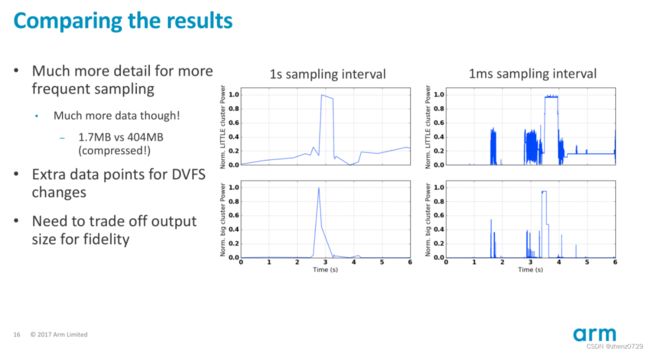gem5学习(17):ARM功耗建模——ARM Power Modelling
目录
一、Dynamic Power States
二、Power Usage Types
三、MathExprPowerModels
四、Extending an existing simulation
五、Stat dump frequency
六、Common Problems
官网教程:gem5: ARM Power Modelling
通过使用gem5中已记录的各种统计数据,可以在gem5模拟中对能量和功率使用(energy and power usage)进行建模和监控。这是通过使用MathExprPowerModel实现的,它是一种通过数学方程来建模功率使用的方法。本教程详细介绍了功耗建模所需的各个组件,并解释了如何将它们添加到现有的ARM模拟中。
本章借鉴了位于configs/example/arm目录中的fs_power.py配置脚本,并提供了扩展此脚本或其他脚本的说明。
请注意,只有在使用更详细的“timing” CPU时才能应用功耗模型。
关于功耗建模如何集成到gem5中以及它们与模拟器的其他部分如何交互的概述,可以在Sascha Bischoff在2017年ARM Research Summit上的演示中找到。
完整的fs_power.py配置脚本:
import argparse
import os
import m5
from m5.objects import MathExprPowerModel, PowerModel
import fs_bigLITTLE as bL
class CpuPowerOn(MathExprPowerModel):
def __init__(self, cpu_path, **kwargs):
super(CpuPowerOn, self).__init__(**kwargs)
# 2A per IPC, 3pA per cache miss
# and then convert to Watt
self.dyn = (
"voltage * (2 * {}.ipc + 3 * 0.000000001 * "
"{}.dcache.overallMisses / simSeconds)".format(cpu_path, cpu_path)
)
self.st = "4 * temp"
class CpuPowerOff(MathExprPowerModel):
dyn = "0"
st = "0"
class CpuPowerModel(PowerModel):
def __init__(self, cpu_path, **kwargs):
super(CpuPowerModel, self).__init__(**kwargs)
self.pm = [
CpuPowerOn(cpu_path), # ON
CpuPowerOff(), # CLK_GATED
CpuPowerOff(), # SRAM_RETENTION
CpuPowerOff(), # OFF
]
class L2PowerOn(MathExprPowerModel):
def __init__(self, l2_path, **kwargs):
super(L2PowerOn, self).__init__(**kwargs)
# Example to report l2 Cache overallAccesses
# The estimated power is converted to Watt and will vary based
# on the size of the cache
self.dyn = f"{l2_path}.overallAccesses * 0.000018000"
self.st = "(voltage * 3)/10"
class L2PowerOff(MathExprPowerModel):
dyn = "0"
st = "0"
class L2PowerModel(PowerModel):
def __init__(self, l2_path, **kwargs):
super(L2PowerModel, self).__init__(**kwargs)
# Choose a power model for every power state
self.pm = [
L2PowerOn(l2_path), # ON
L2PowerOff(), # CLK_GATED
L2PowerOff(), # SRAM_RETENTION
L2PowerOff(), # OFF
]
def main():
parser = argparse.ArgumentParser(
description="Generic ARM big.LITTLE configuration with "
"example power models"
)
bL.addOptions(parser)
options = parser.parse_args()
if options.cpu_type != "timing":
m5.fatal("The power example script requires 'timing' CPUs.")
root = bL.build(options)
# Wire up some example power models to the CPUs
for cpu in root.system.descendants():
if not isinstance(cpu, m5.objects.BaseCPU):
continue
cpu.power_state.default_state = "ON"
cpu.power_model = CpuPowerModel(cpu.path())
# Example power model for the L2 Cache of the bigCluster
for l2 in root.system.bigCluster.l2.descendants():
if not isinstance(l2, m5.objects.Cache):
continue
l2.power_state.default_state = "ON"
l2.power_model = L2PowerModel(l2.path())
bL.instantiate(options)
print("*" * 70)
print(
"WARNING: The power numbers generated by this script are "
"examples. They are not representative of any particular "
"implementation or process."
)
print("*" * 70)
# Dumping stats periodically
m5.stats.periodicStatDump(m5.ticks.fromSeconds(0.1e-3))
bL.run()
if __name__ == "__m5_main__":
main()
- 实现了一个使用gem5模拟器的ARM big.LITTLE配置,并使用了示例的功耗模型。它定义了几个功耗模型类,包括CpuPowerOn、CpuPowerOff、CpuPowerModel、L2PowerOn、L2PowerOff和L2PowerModel。这些类通过继承MathExprPowerModel和PowerModel来定义不同的功耗模型。
- 主函数main()中首先解析命令行参数,并构建gem5模拟器的系统。然后,将示例的功耗模型与CPU和L2 Cache相关联。对于每个CPU,设置默认的功耗状态为“ON”,并将CpuPowerModel功耗模型与其关联。对于bigCluster的L2 Cache,设置默认的功耗状态为“ON”,并将L2PowerModel功耗模型与其关联。
一、Dynamic Power States
功耗模型由两个函数组成,用于描述如何计算不同功耗状态下的功耗消耗。这些功耗状态包括以下几种(来自src/sim/PowerState.py):
- UNDEFINED:无效状态,没有可用的功耗状态相关信息。这是默认状态。
- ON:逻辑块正在主动运行,并根据所需的处理量消耗动态能量和漏电能量。
- CLK_GATED:块内的时钟电路被关闭以节省动态能量,但块的电源仍然打开,并且块正在消耗漏电能量。
- SRAM_RETENTION:逻辑块内的SRAM被拉入保持状态,进一步减少漏电能量。
- OFF:逻辑块被断电,不消耗任何能量。
每个状态(除了UNDEFINED)都分配了一个功耗模型,使用PowerModel类的pm字段。它是一个包含4个功耗模型的列表,分别对应以下顺序的状态:
- ON
- CLK_GATED
- SRAM_RETENTION
- OFF
需要注意的是,虽然有4个不同的条目,但这些条目不一定是不同的功耗模型。提供的fs_power.py文件在ON状态使用一个功耗模型,然后在其余状态使用相同的功耗模型。
二、Power Usage Types
gem5模拟器对功耗使用模拟了两种类型:
- 静态功耗(static):模拟系统在任何活动情况下使用的功耗。
- 动态功耗(dynamic):由于各种活动而导致系统使用的功耗。
一个功耗模型必须包含用于模拟这两种功耗的方程(这个方程可以非常简单,比如,如果不需要或者与该功耗模型无关的静态功耗,可以将其设为st = "0")。
三、MathExprPowerModels
在fs_power.py中提供的功耗模型是继承自MathExprPowerModel类的。MathExprPowerModel是指定为包含用于计算系统功耗的数学表达式的字符串。它们通常包含了一些统计数据和自动变量,比如温度,例如:
class CpuPowerOn(MathExprPowerModel):
def __init__(self, cpu_path, **kwargs):
super(CpuPowerOn, self).__init__(**kwargs)
# 2A per IPC, 3pA per cache miss
# and then convert to Watt
self.dyn = "voltage * (2 * {}.ipc + 3 * 0.000000001 * " \
"{}.dcache.overall_misses / sim_seconds)".format(cpu_path,
cpu_path)
self.st = "4 * temp"上述的功耗模型来源于提供的fs_power.py文件。
可以看到自动变量(电压和温度【voltage and temp】)不需要路径,而组件特定的统计信息(CPU的每周期指令ipc)需要路径。在文件的主函数中,可以看到CPU对象有一个path()函数,返回组件在系统中的“路径”,例如system.bigCluster.cpus0。path函数由SimObject提供,因此可以被系统中任何扩展了SimObject的对象使用,例如稍后几行中的L2缓存对象也使用了它。
(注意将dcache.overall_misses除以sim_seconds以转换为瓦特。这是一个功耗模型,即能量随时间的变化。在使用这些术语时要小心,因为它们通常可以互换使用,但在功耗和能量模拟/建模方面,它们具有非常具体的含义。)
四、Extending an existing simulation
提供的fs_power.py脚本通过导入现有的fs_bigLITTLE.py脚本并修改其值来进行扩展。作为其中的一部分,使用了几个循环来迭代SimObjects的后代,以应用功耗模型。因此,为了扩展现有的仿真以支持功耗模型,可以定义一个辅助函数来帮助完成这个任务。
def _apply_pm(simobj, power_model, so_class=None):
for desc in simobj.descendants():
if so_class is not None and not isinstance(desc, so_class):
continue
desc.power_state.default_state = "ON"
desc.power_model = power_model(desc.path())上述函数接受一个SimObject、一个Power Model和一个可选的类,SimObject的子孙必须实例化该类才能应用PM。如果没有指定类,则PM将应用于所有子孙。
无论是否决定使用辅助函数,现在需要定义一些Power Models。可以按照fs_power.py文件中的模式进行操作:
- 为感兴趣的每个功耗状态定义一个类。这些类应该扩展MathExprPowerModel,并包含dyn和st字段(分别表示动态和静态功耗)。每个字段应包含一个字符串,描述在该状态下如何计算各自类型的功耗。它们的构造函数应接受一个路径,用于通过格式在描述功耗计算方程的字符串中使用,并接受一些kwargs参数,以传递给超级构造函数。
- 定义一个类来保存在上一步中定义的所有Power Models。这个类应该扩展PowerModel,并包含一个名为pm的单一字段,其中包含一个包含4个元素的列表:pm[0]应该是“ON”功耗状态的Power Model的实例;pm[1]应该是“CLK_GATED”功耗状态的Power Model的实例;等等。这个类的构造函数应接受要传递给各个Power Models的路径,以及一些kwargs参数,这些参数将传递给超级构造函数。
- 有了辅助函数和上述类的定义,您可以扩展build函数,并在addOptions函数中添加一个命令行标志(如果希望能够切换使用这些模型)。
示例实现:
class CpuPowerOn(MathExprPowerModel):
def __init__(self, cpu_path, **kwargs):
super(CpuPowerOn, self).__init__(**kwargs)
self.dyn = "voltage * 2 * {}.ipc".format(cpu_path)
self.st = "4 * temp"
class CpuPowerClkGated(MathExprPowerModel):
def __init__(self, cpu_path, **kwargs):
super(CpuPowerOn, self).__init__(**kwargs)
self.dyn = "voltage / sim_seconds"
self.st = "4 * temp"
class CpuPowerOff(MathExprPowerModel):
dyn = "0"
st = "0"
class CpuPowerModel(PowerModel):
def __init__(self, cpu_path, **kwargs):
super(CpuPowerModel, self).__init__(**kwargs)
self.pm = [
CpuPowerOn(cpu_path), # ON
CpuPowerClkGated(cpu_path), # CLK_GATED
CpuPowerOff(), # SRAM_RETENTION
CpuPowerOff(), # OFF
]
[...]
def addOptions(parser):
[...]
parser.add_argument("--power-models", action="store_true",
help="Add power models to the simulated system. "
"Requires using the 'timing' CPU."
return parser
def build(options):
root = Root(full_system=True)
[...]
if options.power_models:
if options.cpu_type != "timing":
m5.fatal("The power models require the 'timing' CPUs.")
_apply_pm(root.system.bigCluster.cpus, CpuPowerModel
so_class=m5.objects.BaseCpu)
_apply_pm(root.system.littleCluster.cpus, CpuPowerModel)
return root
[...]五、Stat dump frequency
默认情况下,gem5每模拟一秒钟就将模拟统计信息转储到stats.txt文件中。可以通过m5.stats.periodicStatDump函数进行控制,该函数接受以模拟时钟周期为单位的统计信息转储频率,而不是以秒为单位。同时,m5.ticks提供了一个fromSeconds函数,以便于使用。
下面是一个示例,展示了统计信息转储频率如何影响结果的分辨率,取自Sascha Bischoff的演示幻灯片第16页:
统计信息转储的频率直接影响基于stats.txt文件生成的图表的分辨率。然而,它也会影响输出文件的大小。每模拟一秒转储统计信息与每模拟一毫秒转储统计信息相比,会增加文件大小几百倍。因此,有意控制统计信息转储频率是合理的。
使用提供的fs_power.py脚本,可以按以下方式进行设置:
[...]
def addOptions(parser):
[...]
parser.add_argument("--stat-freq", type=float, default=1.0,
help="Frequency (in seconds) to dump stats to the "
"'stats.txt' file. Supports scientific notation, "
"e.g. '1.0E-3' for milliseconds.")
return parser
[...]
def main():
[...]
m5.stats.periodicStatDump(m5.ticks.fromSeconds(options.stat_freq))
bL.run()
[...]可以使用以下方式指定统计信息转储频率:
--stat-freq 在调用模拟时进行设置。
六、Common Problems
使用提供的fs_power.py时,gem5崩溃,并显示以下错误消息:致命错误:统计信息''(160)未通过regStats()函数正确初始化
使用提供的fs_power.py时,gem5崩溃,并显示以下错误消息:致命错误:无法评估功耗表达式:[...]
这是因为gem5的统计框架最近进行了重构。获取最新版本的gem5源代码并重新构建应该可以解决这个问题。如果不希望这样做,可以使用以下两组补丁:
- https://gem5-review.googlesource.com/c/public/gem5/+/26643
- https://gem5-review.googlesource.com/c/public/gem5/+/26785
可以通过按照各自链接中的下载说明来检出和应用这些补丁。
前阵子放假断更了一段时间(在家除了学习都是有意思的事情),现在逐步开始捡起学习状态。
